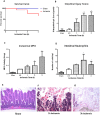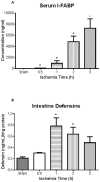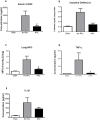I-FABP as biomarker for the early diagnosis of acute mesenteric ischemia and resultant lung injury
- PMID: 25541714
- PMCID: PMC4277349
- DOI: 10.1371/journal.pone.0115242
I-FABP as biomarker for the early diagnosis of acute mesenteric ischemia and resultant lung injury
Abstract
Acute mesenteric ischemia (AMI) is a life-threatening condition that can result in multiple organ injury and death. A timely diagnosis and treatment would have a significant impact on the morbidity and mortality in high-risk patient population. The purpose of this study was to investigate if intestinal fatty acid binding protein (I-FABP) and α-defensins can be used as biomarkers for early AMI and resultant lung injury. C57BL/6 mice were subjected to intestinal ischemia by occlusion of the superior mesenteric artery. A time course of intestinal ischemia from 0.5 to 3 h was performed and followed by reperfusion for 2 h. Additional mice were treated with N-acetyl-cysteine (NAC) at 300 mg/kg given intraperitoneally prior to reperfusion. AMI resulted in severe intestinal injury characterized by neutrophil infiltrate, myeloperoxidase (MPO) levels, cytokine/chemokine levels, and tissue histopathology. Pathologic signs of ischemia were evident at 1 h, and by 3 h of ischemia, the full thickness of the intestine mucosa had areas of coagulative necrosis. It was noted that the levels of α-defensins in intestinal tissue peaked at 1 h and I-FABP in plasma peaked at 3 h after AMI. Intestinal ischemia also resulted in lung injury in a time-dependent manner. Pretreatment with NAC decreased the levels of intestinal α-defensins and plasma I-FABP, as well as lung MPO and cytokines. In summary, the concentrations of intestinal α-defensins and plasma I-FABP predicted intestinal ischemia prior to pathological evidence of ischemia and I-FABP directly correlated with resultant lung injury. The antioxidant NAC reduced intestinal and lung injury induced by AMI, suggesting a role for oxidants in the mechanism for distant organ injury. I-FABP and α-defensins are promising biomarkers, and may guide the treatment with antioxidant in early intestinal and distal organ injury.
Conflict of interest statement
Figures





References
-
- Klempnauer J, Grothues F, Bektas H, Pichlmayr R (1997) Long-term results after surgery for acute mesenteric ischemia. Surgery 121:239–243. - PubMed
-
- Wilcox MG, Howard TJ, Plaskon LA, Unthank JL, Madura JA (1995) Current theories of pathogenesis and treatment of nonocclusive mesenteric ischemia. Dig Dis Sci 40:709–716. - PubMed
-
- Kassahun WT, Schulz T, Richter O, Hauss J (2008) Unchanged high mortality rates from acute occlusive intestinal ischemia: six year review. Langenbecks Arch Surg 393:163–171. - PubMed
-
- Evennett NJ, Petrov MS, Mittal A, Windsor JA (2009) Systematic review and pooled estimates for the diagnostic accuracy of serological markers for intestinal ischemia. World J Surg 33:1374–1383. - PubMed
Publication types
MeSH terms
Substances
Grants and funding
LinkOut - more resources
Full Text Sources
Other Literature Sources
Research Materials
Miscellaneous

